Research on the Internal Thermal Boundary Conditions of Concrete Closed Girder Cross-Sections under Historically Extreme Temperature Conditions
Abstract
Featured Application
Abstract
1. Introduction
2. Finite Element Simulation
2.1. Box Girder
2.2. Small Box Girder
2.3. Adjacent Box Girder
3. Influence of Different Simulation Methods for Internal Thermal Boundary Conditions
3.1. Box Girder
3.1.1. Influence on the Hourly Temperature Curves
3.1.2. Influence on the Temperature Contour Plots
3.1.3. Influence on the Average Effective Temperatures and Vertical Temperature Gradients
3.2. Small Box Girder
3.2.1. Influence on the Hourly Temperature Curves
3.2.2. Influence on the Temperature Contour Plots
3.2.3. Influence on the Average Effective Temperatures and Vertical Temperature Gradients
3.3. Adjacent Box Girder
3.3.1. Influence on the Hourly Temperature Curves
3.3.2. Influence on the Temperature Contour Plots
3.3.3. Influence on the Average Effective Temperatures and Vertical Temperature Gradients
4. Temperature Distributions on Concrete Closed Girder Cross-Sections under Historically Extreme Temperature Conditions
4.1. Meteorological Data
4.2. Average Effective Temperatures of Cross-Sections
4.3. Vertical Temperature Gradients
5. Summary
- (1)
- The Measured Temperature Method can reflect the actual temperatures inside the cavities, but measurements on site are cost- and time-prohibitive. Therefore, the application range of the Measured Temperature Method is limited. When there is no measurement on site to obtain the temperature inside the cavity, the Ambient Temperature Method, Mean Temperature Method, or Air Element Method can be used as alternative methods.
- (2)
- The influences of different simulation methods for the internal thermal boundary conditions on the numerical hourly temperature curves of the parts of cross-sections far from the cavities are negligible. Compared with the measured hourly temperature curves, the numerical hourly temperature curves of the parts of the cross-sections near the cavities calculated by the Measured Temperature Method provide the closest agreement. When there is a lack of measured temperature inside the cavity, the numerical hourly temperature curves calculated by the Air Element Method provide a closer agreement with the measured curves than the curves calculated by the Ambient Temperature Method and Mean Temperature Method. When the Ambient Temperature Method is used, the trends of the numerical curves of the bottom flanges and the webs near the bottom flanges are similar to the measured hourly ambient air temperature curve, because the temperature change in the hourly ambient air temperature curve was much larger than the temperature changes in the measured curves inside the cavities.
- (3)
- The comparisons of the temperature contour plots obtained from the FEMs considering different simulation methods for the internal thermal boundary conditions indicated that the temperature distributions on the parts near the cavities calculated by the Measured Temperature Method and Air Element Method were close to the measured values.
- (4)
- The influences of different simulation methods for the internal thermal boundary conditions on the highest hourly average effective temperature of concrete closed girder cross-sections and the trends of the vertical temperature gradients for the box girder and adjacent box girder cross-sections were small. The maximum vertical temperature gradients calculated by the Air Element Method on the top and bottom flanges were larger than those calculated by the Ambient Temperature Method and Mean Temperature Method for the small box girder cross-sections.
- (5)
- The Air Element Method can be used as a simulation method for the internal thermal boundary conditions in the FEM to predict the temperature distributions on concrete closed girder cross-sections under historically extreme temperature conditions. The longitudinal thermal movement of concrete closed girders calculated by the one-year measured average effective temperature of the cross-sections or by the Chinese-code-specified effective temperatures for the highway bridge structures would be smaller than those under historically extreme temperature conditions, which are thus unconservative for engineering applications. It is suggested that the average effective temperature of concrete closed girder cross-sections under historically extreme temperature conditions should be calculated for each city using the FEM with the Air Element Method, as described in this paper. The comparisons of vertical temperature gradients under historically extreme temperature conditions indicate that the Chinese-code-specified vertical temperature gradients are conservative for the bridge deck surfaces and unconservative for the bottom flanges.
- (6)
- Further research has been carried out to analyze the average effective temperatures and vertical temperature gradients of concrete closed girder cross-sections under historically extreme temperature conditions for each city in China using the FEM with the Air Element Method described in this paper.
Supplementary Materials
Author Contributions
Funding
Acknowledgments
Conflicts of Interest
References
- Lall, J.; Alampalli, S.; DiCocco, E.F. Performance of full depth shear keys in adjacent prestressed box beam bridges. PCI J. 1998, 43, 72–79. [Google Scholar] [CrossRef]
- Miller, R.A.; Hlavacs, G.M.; Long, T.; Greuel, A. Full-scale testing of shear keys for adjacent box girder bridges. PCI J. 1999, 44, 80–90. [Google Scholar] [CrossRef]
- Sennah, K.M.; Kennedy, J.B. Literature review in analysis of box-girder bridges. J. Bridge Eng. 2002, 7, 134–143. [Google Scholar] [CrossRef]
- Russell, H.G. Adjacent precast concrete box-beam bridges: State of the practice. PCI J. 2011, 56, 75–91. [Google Scholar] [CrossRef]
- Pan, Z.F.; You, F.C. Quantitative design of backup prestressing tendons for long-span prestressed concrete box girder bridges. J. Bridge Eng. 2015, 20. [Google Scholar] [CrossRef]
- Yuan, J.Q.; Graybeal, B. Full-scale testing of shear key details for precast concrete box-beam bridges. J. Bridge Eng. 2016, 21. [Google Scholar] [CrossRef]
- Xue, J.Q.; Briseghella, B.; Lin, J.H.; Huang, F.Y.; Chen, B.C. Design and field tests of a deck-extension bridge with small box girder. J. Traff. Transp. Eng. 2018, 5, 467–479. [Google Scholar] [CrossRef]
- Xu, Z.; Chen, B.C.; Zhuang, Y.Z.; Tabatabai, H.; Huang, F.Y. Rehabilitation and retrofitting of a multispan simply-supported adjacent box girder bridge into a jointless and continuous structure. J. Perform. Constr. Fac. 2018, 32. [Google Scholar] [CrossRef]
- Huang, H.D.; Huang, S.S.; Pilakoutas, K. Modeling for assessment of long-term behavior of prestressed concrete box-girder bridges. J. Bridge Eng. 2018, 23. [Google Scholar] [CrossRef]
- Gupta, T.; Kumar, M. Flexural response of skew-curved concrete box-girder bridges. Eng. Struct. 2018, 163, 358–372. [Google Scholar] [CrossRef]
- Hussein, H.H.; Sargand, S.M.; Steinberg, E.P. Shape optimization of uhpc shear keys for precast, prestressed, adjacent box-girder bridges. J. Bridge Eng. 2018, 23. [Google Scholar] [CrossRef]
- Hussein, H.H.; Sargand, S.M.; Khoury, I. Field investigation of ultra-high performance concrete shear key in an adjacent box-girder bridge. Struct. Infrastruct. Eng. 2019, 15, 663–678. [Google Scholar] [CrossRef]
- Lin, J.H.; Briseghella, B.; Xue, J.Q.; Tabatabai, H.; Huang, F.Y.; Chen, B.C. Temperature monitoring and response of deck-extension side-by-side box girder bridges. J. Perform. Constr. Fac. 2020, 34, 04019122. [Google Scholar] [CrossRef]
- Elbadry, M.M.; Ghali, A. Temperature variations in concrete bridges. J. Struct. Eng. 1983, 109, 2355–2374. [Google Scholar] [CrossRef]
- Dilger, W.H.; Ghali, A.; Chan, M.; Cheung, M.S.; Maes, M.A. Temperature stresses in composite box girder bridges. J. Struct. Eng. 1983, 109, 1460–1478. [Google Scholar] [CrossRef]
- Elbadry, M.; Ghali, A. Thermal stresses and cracking of concrete bridges. ACI J. 1986, 83, 1001–1009. [Google Scholar]
- Mirambell, E.; Aguado, A. Temperature and stress distributions in concrete box girder bridges. J. Struct. Eng. 1990, 116, 2388–2409. [Google Scholar] [CrossRef]
- Massicotte, B.; Picard, A.; Gaumond, Y.; Ouellet, C. Strengthening of long span prestressed segmental box girder bridge. PCI J. 1994, 39, 52–65. [Google Scholar] [CrossRef]
- Saetta, A.; Scotta, R.; Vitaliani, R. Stress analysis of concrete structures subjected to variable thermal loads. J. Struct. Eng. 1995, 121, 446–457. [Google Scholar] [CrossRef]
- Li, D.N.; Maes, M.A.; Dilger, W.H. Thermal design criteria for deep prestressed concrete girders based on data from confederation bridge. Can. J. Civil. Eng. 2004, 31, 813–825. [Google Scholar] [CrossRef]
- Lee, J.H. Investigation of extreme environmental conditions and design thermal gradients during construction for prestressed concrete bridge girders. J. Bridge Eng. 2012, 17, 547–556. [Google Scholar] [CrossRef]
- Rodriguez, L.E.; Barr, P.J.; Halling, M.W. Temperature effects on a box-girder integral-abutment bridge. J. Perform. Constr. Fac. 2014, 28, 583–591. [Google Scholar] [CrossRef]
- Tayşi, N.; Abid, S. Temperature distributions and variations in concrete box-girder bridges: Experimental and finite element parametric studies. Adv. Struct. Eng. 2015, 18, 469–486. [Google Scholar] [CrossRef]
- Abid, S.R.; Tayşi, N.; Özakça, M. Experimental analysis of temperature gradients in concrete box-girders. Constr. Build. Mater. 2016, 106, 523–532. [Google Scholar] [CrossRef]
- Xue, J.Q.; Lin, J.H.; Briseghella, B.; Tabatabai, H.; Chen, B.C. Solar radiation parameters for assessing temperature distributions on bridge cross-sections. Appl. Sci. Basel 2018, 8, 627. [Google Scholar] [CrossRef]
- Liu, Y.J.; Liu, J.; Zhang, N. Review on solar thermal actions of bridge structures. China Civ. Eng. J. 2019, 52, 59–78. [Google Scholar]
- England, G.L.; Tsang, N.C.M.; Bush, D.I. Integral Bridges: A Fundamental Approach to the Time-Temperature Loading Problem; Thomas Telford: London, UK, 2000; ISBN 9780727735416. [Google Scholar]
- Oesterle, R.G.; Tabatabai, H.; Lawson, T.J.; Refai, T.M.; Volz, J.S.; Scanlon, A. Jointless Bridges, Summary Report; Federal Highway Administration: Washington DC, USA, 2005.
- Zordan, T.; Briseghella, B. Attainment of an integral abutment bridge through the refurbishment of a simply supported structure. Struct. Eng. Int. 2007, 17, 228–234. [Google Scholar] [CrossRef]
- Briseghella, B.; Zordan, T. Integral abutment bridge concept applied to the rehabilitation of a simply supported concrete structure. Struct. Concr. 2007, 8, 25–33. [Google Scholar] [CrossRef]
- Zordan, T.; Briseghella, B.; Lan, C. Parametric and pushover analyses on integral abutment bridge. Eng. Struct. 2011, 33, 502–515. [Google Scholar] [CrossRef]
- Zordan, T.; Briseghella, B.; Lan, C. Analytical formulation for limit length of integral abutment bridges. Struct. Eng. Int. 2011, 21, 304–310. [Google Scholar] [CrossRef]
- Briseghella, B.; Zordan, T. An innovative steel-concrete joint for integral abutment bridges. J. Traff. Transp. Eng. 2015, 2, 209–222. [Google Scholar] [CrossRef]
- Xue, J.Q.; Briseghella, B.; Chen, B.C.; Zhang, P.Q.; Zordan, T. Optimal design of pile foundation in fully integral abutment bridge. In Developments in International Bridge Engineering; Caner, A., Gulkan, P., Mahmoud, K., Eds.; Springer International Publishing AG: Cham, Switzerland, 2016; Volume 9, pp. 3–15. ISBN 9783319197852. [Google Scholar]
- Huang, F.Y.; Qian, H.M.; Zhuang, Y.Z.; Fu, C. Experimental study on the dynamic response of phc pipe-piles in liquefiable soil. J. Test. Eval. 2017, 45, 230–241. [Google Scholar] [CrossRef]
- Xue, J.Q.; Chen, B.C.; Briseghella, B.; Dong, J.C.; Zhang, P.Q. Design, Construction and monitoring of deck-extension bridge deck in expressway. J. China Foreign Highw. 2018, 38, 76–82. [Google Scholar]
- Xue, J.Q.; Lavorato, D.; Bergami, A.V.; Nuti, C.; Briseghella, B.; Marano, G.C.; Ji, T.; Vanzi, I.; Tarantino, A.M.; Santini, S. Severely damaged reinforced concrete circular columns repaired by turned steel rebar and high-performance concrete jacketing with steel or polymer fibers. Appl. Sci. Basel 2018, 8, 1671. [Google Scholar] [CrossRef]
- Huang, F.Y.; Wu, S.W.; Luo, X.Y.; Chen, B.C.; Lin, Y.W. Pseudo-static low cycle test on the mechanical behavior of PHC pipe piles with consideration of soil-pile interaction. Eng. Struct. 2018, 171, 992–1006. [Google Scholar] [CrossRef]
- Xue, J.Q.; Chen, B.C.; Lin, J.H. Study of temperature expansion and contraction deformation of bridges with their deck slabs extended by hollow slabs. Bridge Constr. 2018, 48, 37–42. [Google Scholar]
- Emerson, M. Thermal Movements of Concrete Bridges: Field Measurements and Methods of Prediction; Transport and Road Research Laboratory: Berkshire, UK, 1982. [Google Scholar]
- Clark, J.H. Evaluation of Thermal Stresses in a Concrete Box Girder Bridge. Ph.D. Thesis, University of Washington, Washington, DC, USA, 1989. [Google Scholar]
- Fang, Z.; Wang, J. Sun light thermal difference effect on long-span pc continuous box girder bridge. China J. Highw. Transp. 2007, 20, 62–67. [Google Scholar]
- Chen, X.Q. Temperature Analysis of Steel-concrete Composite Girder Caused by Solar Radiation. In Proceedings of the Eighteenth National Conference on Structural Engineering, Guangzhou, China, 28 November 2009. [Google Scholar]
- Wang, J.; Fang, Z. Temperature variation of concrete box girder bridge. Front. Archit. Civ. Eng. China 2009, 3, 407–413. [Google Scholar] [CrossRef]
- Liu, Y. Research on Temperature Deformation of Extended Slab Concrete Jointless Bridges. Master’s Thesis, Fuzhou University, Fuzhou, China, 2016. [Google Scholar]
- Zhou, L.R.; Liang, C.F.; Chen, L.; Xia, Y. Numerical simulation method of thermal analysis for bridges without using field measurements. Procedia Eng. 2017, 210, 240–245. [Google Scholar] [CrossRef]
- Lin, J.H.; Briseghella, B.; Xue, J.Q.; Huang, F.Y.; Chen, B.C. Research on influence of material thermal parameters on temperature distribution on cross-section of concrete box girder. J. Guangxi Univ. (Nat. Sci. Ed.) 2020, 45, 1–8. (in press).
- Zhang, X.Y. Practical Handbook of Chemistry, 2nd ed.; National Defense Industry Press: Beijing, China, 2011; ISBN 7118004243. [Google Scholar]
- Zhang, J.Y.; Zhao, L.; Deng, S.; Xu, W.C.; Zhang, Y. A critical review of the models used to estimate solar radiation. Renew. Sustain. Energy Rev. 2017, 70, 314–329. [Google Scholar] [CrossRef]
- Ministry of Transport of the People’s Republic of China. General Specifications for Design of Highway Bridges and Culverts; JTG D60-2015; China Communications Press: Beijing, China, 2015. [Google Scholar]
- National Meteorological Information Center. Available online: http://data.cma.cn (accessed on 28 November 2019).
- Brooks, C.E.P.; Carruthers, N. Handbook of statistical methods in meteorology. Geogr. Rev. 1953, 44, 617. [Google Scholar]
- Lin, J.H.; Briseghella, B.; Xue, J.Q.; Tabatabai, H.; Chen, B.C.; Huang, F.Y. Research on Effective Temperature of T-Shaped Girder for Jointless Bridges in China. In Proceedings of the 20th IABSE congress, New York, NY, USA, 4–6 September 2019. [Google Scholar]
- Duffie, J.A.; Beckman, W.A. Solar Engineering of Thermal Processes, 4th ed.; John Wiley & Sons, Inc.: Hoboken, NJ, USA, 2013; ISBN 9781118415412. [Google Scholar]
- NASA Prediction of Worldwide Energy Resources. Available online: https://power.larc.nasa.gov (accessed on 28 November 2019).
- Kehlbeck, F. Einfluss der Sonnenstrahlung bei Bruckenbauwerken; Werner: Dusseldorf, Germany, 1975. [Google Scholar]
- Ministry of Transport of the People’s Republic of China. Wind-Resistant Design Specification for Highway Bridges; JTG/T 3360-01-2018; China Communications Press: Beijing, China, 2018. [Google Scholar]

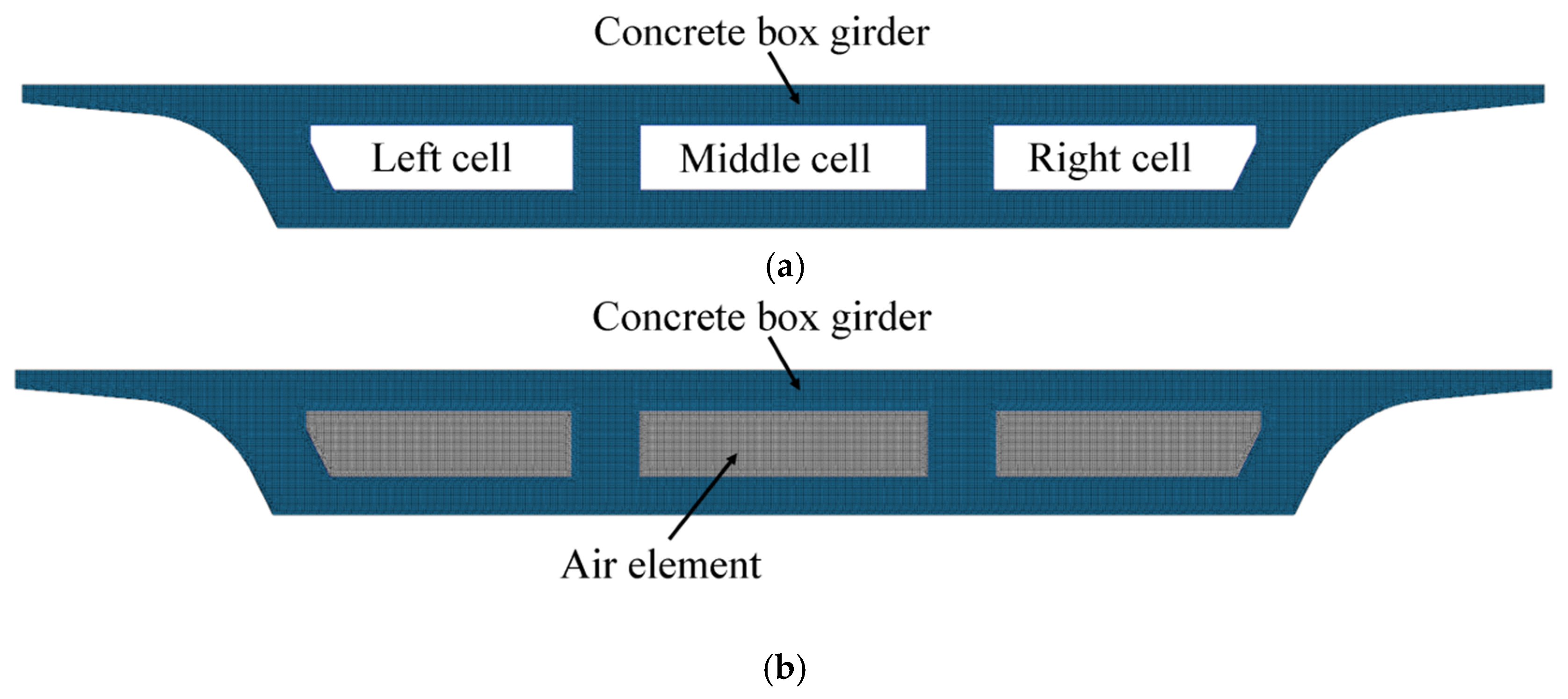
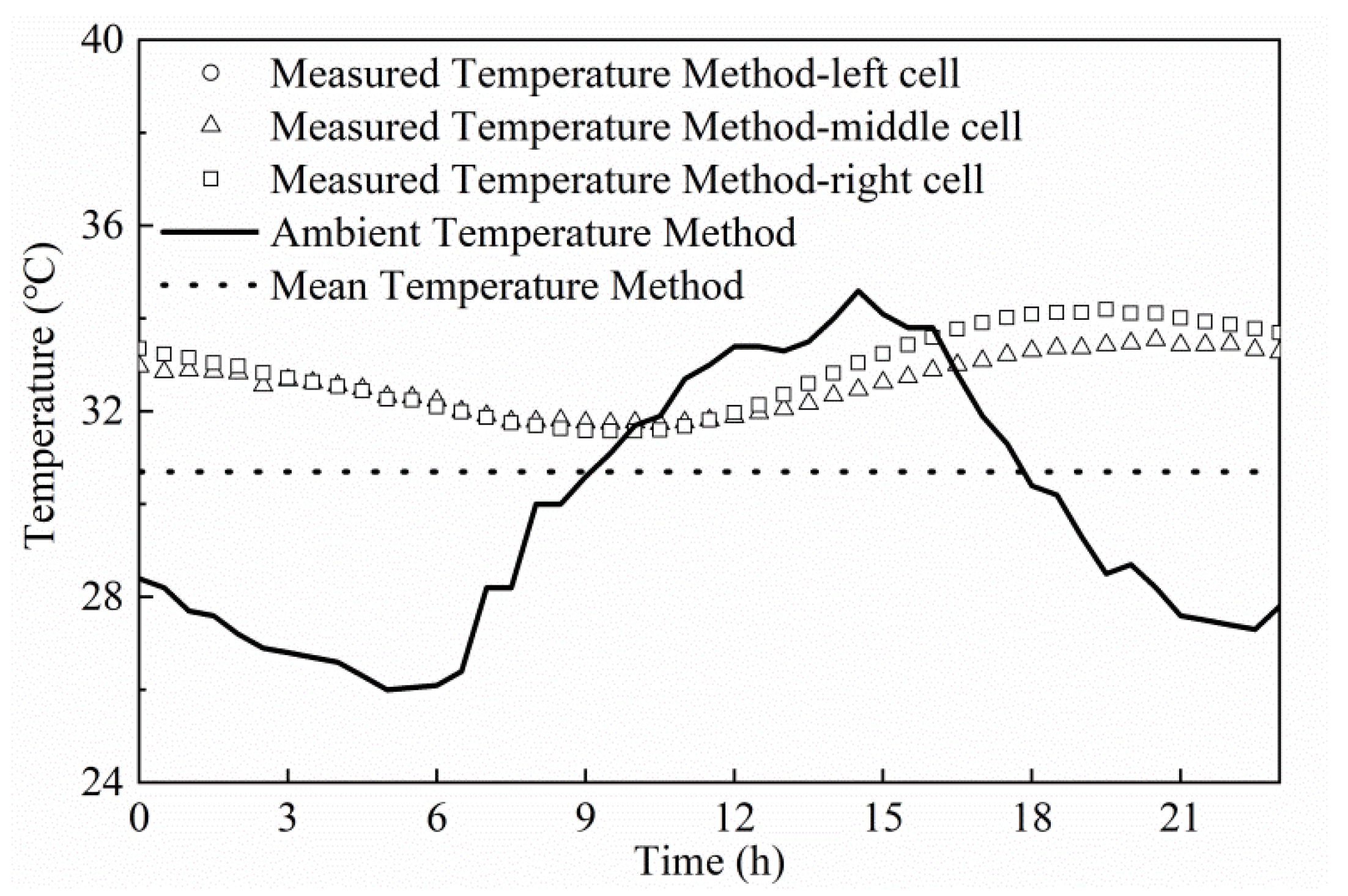

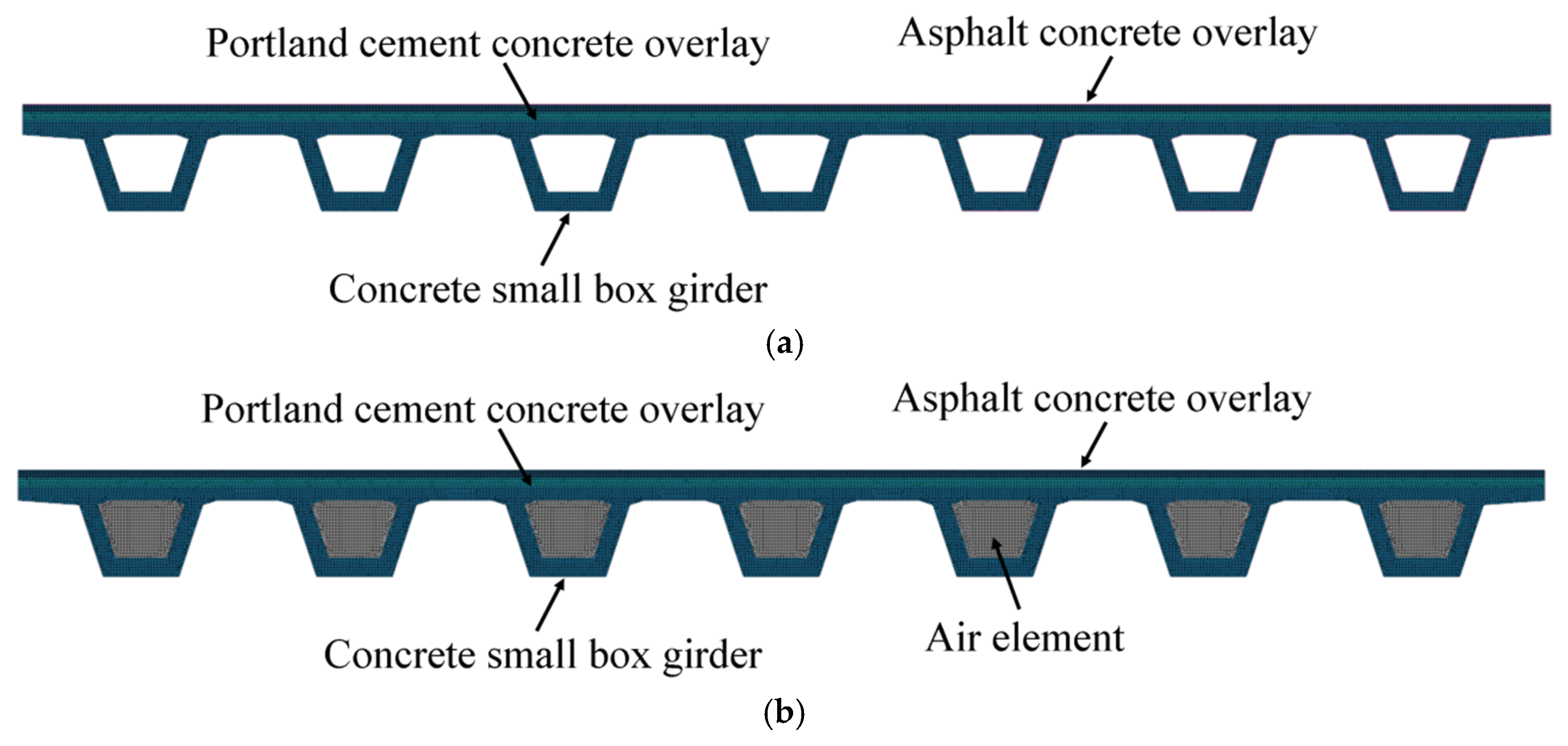
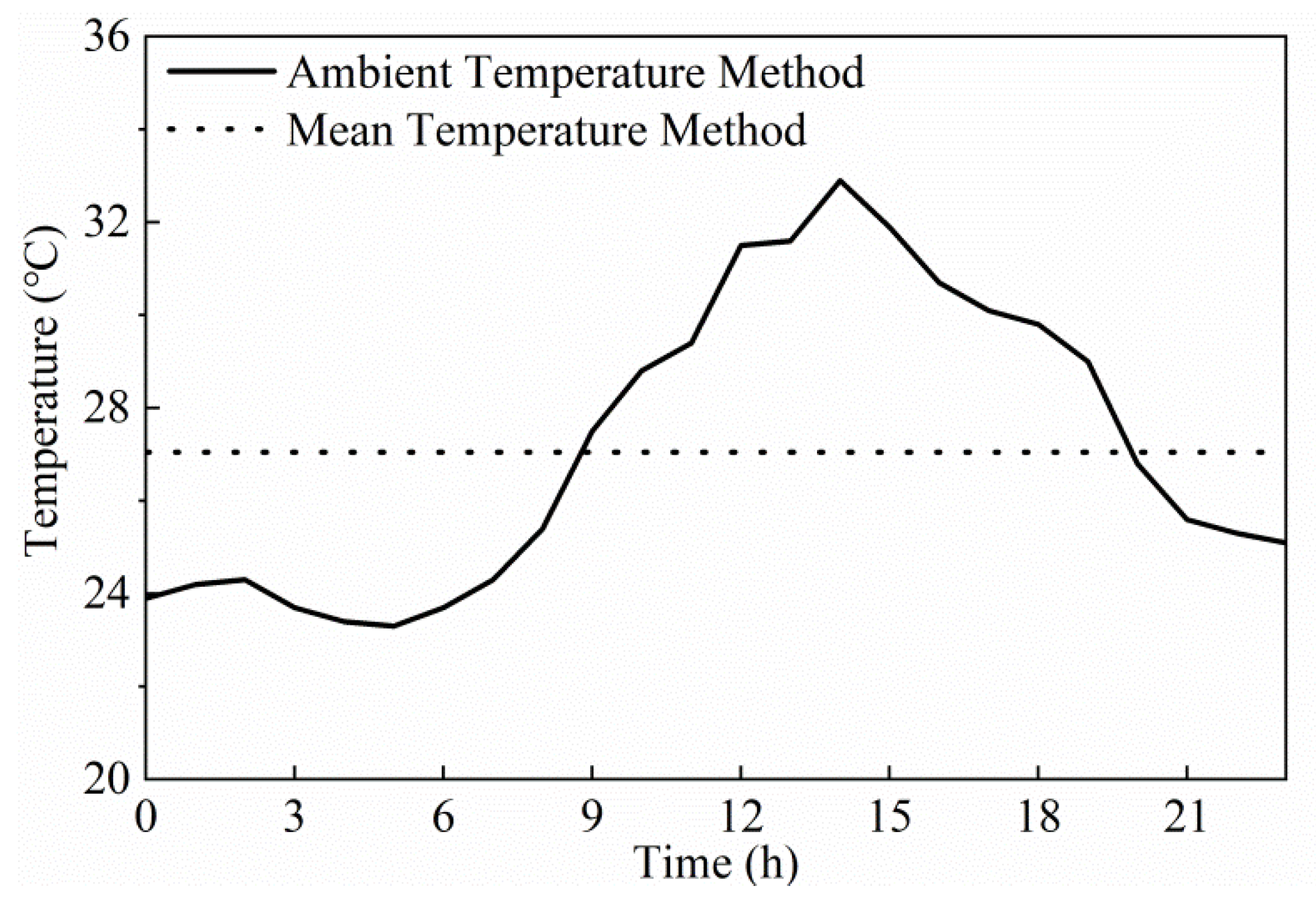

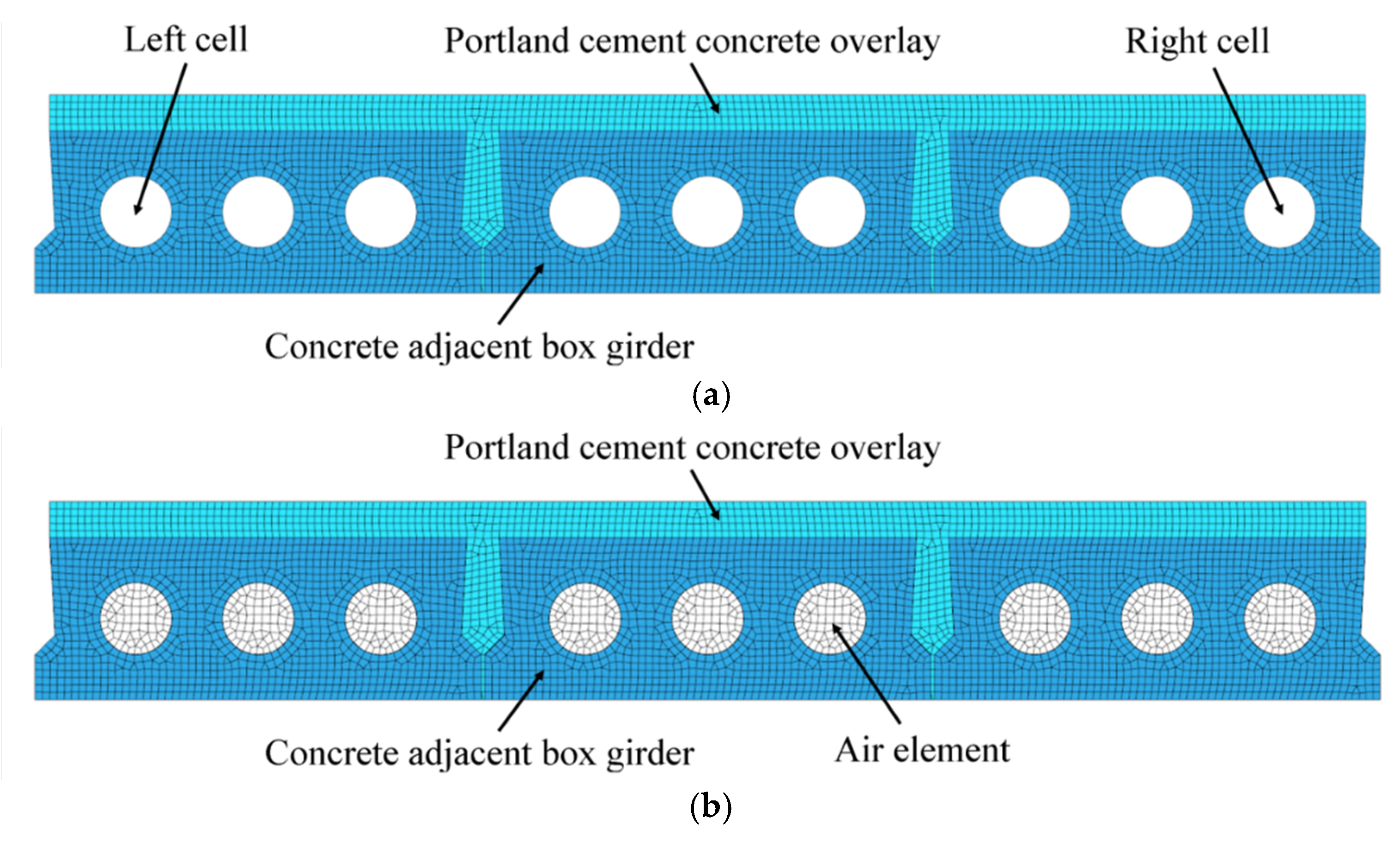
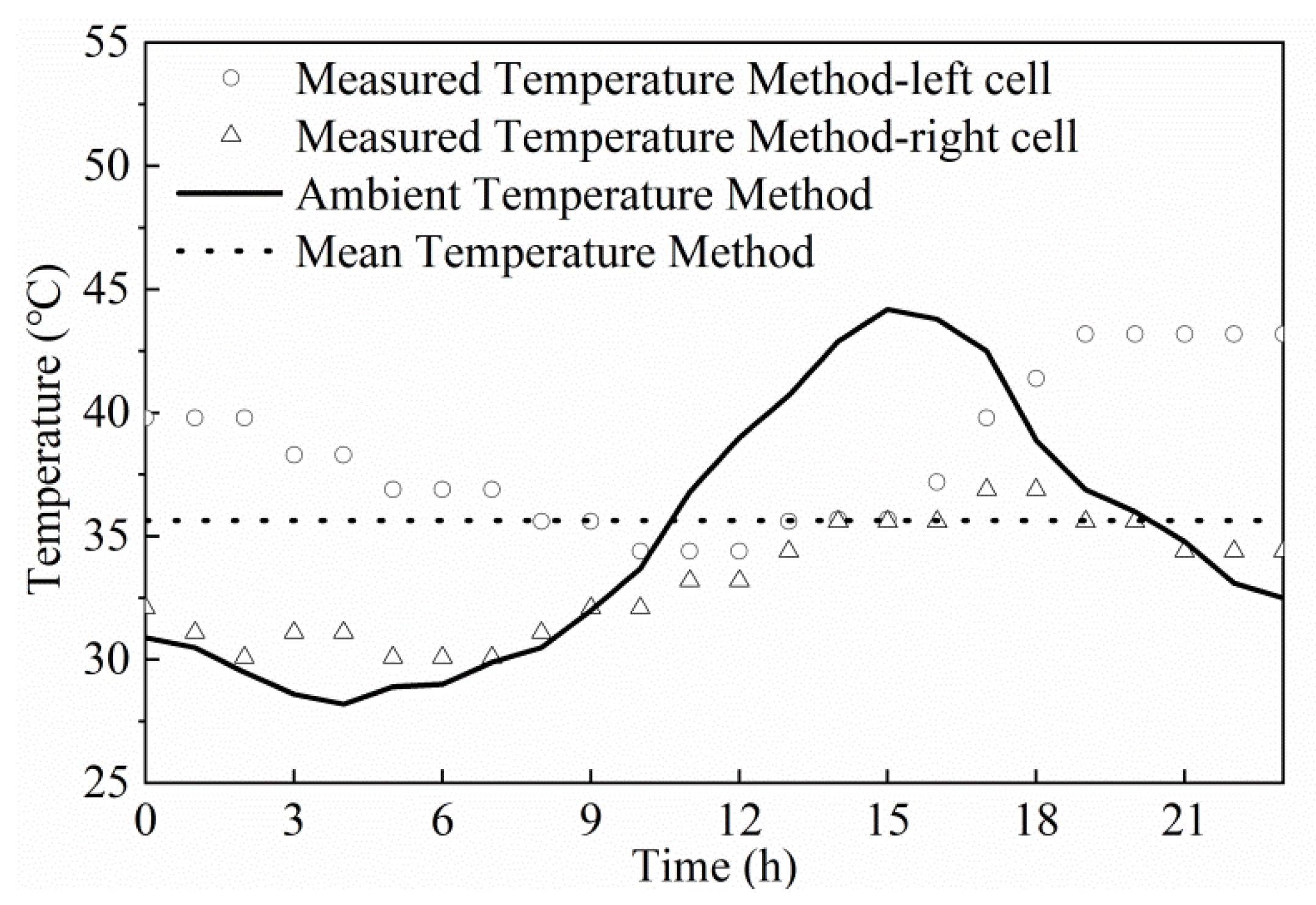
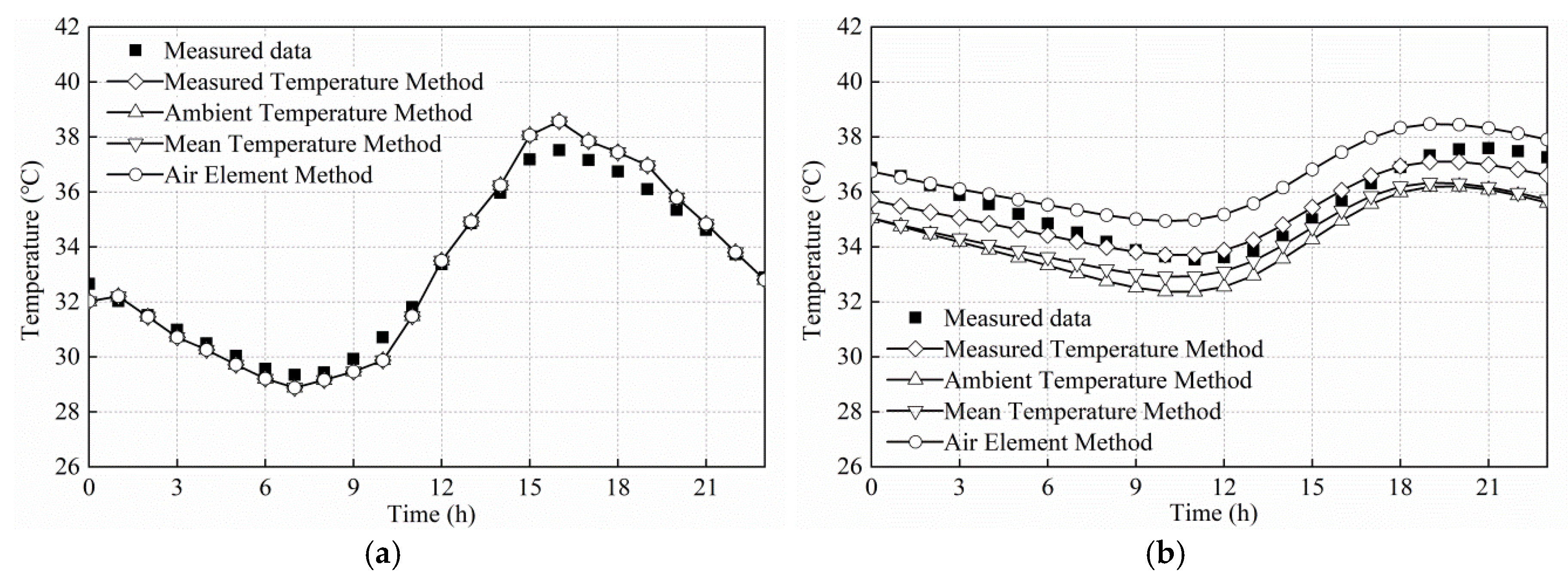
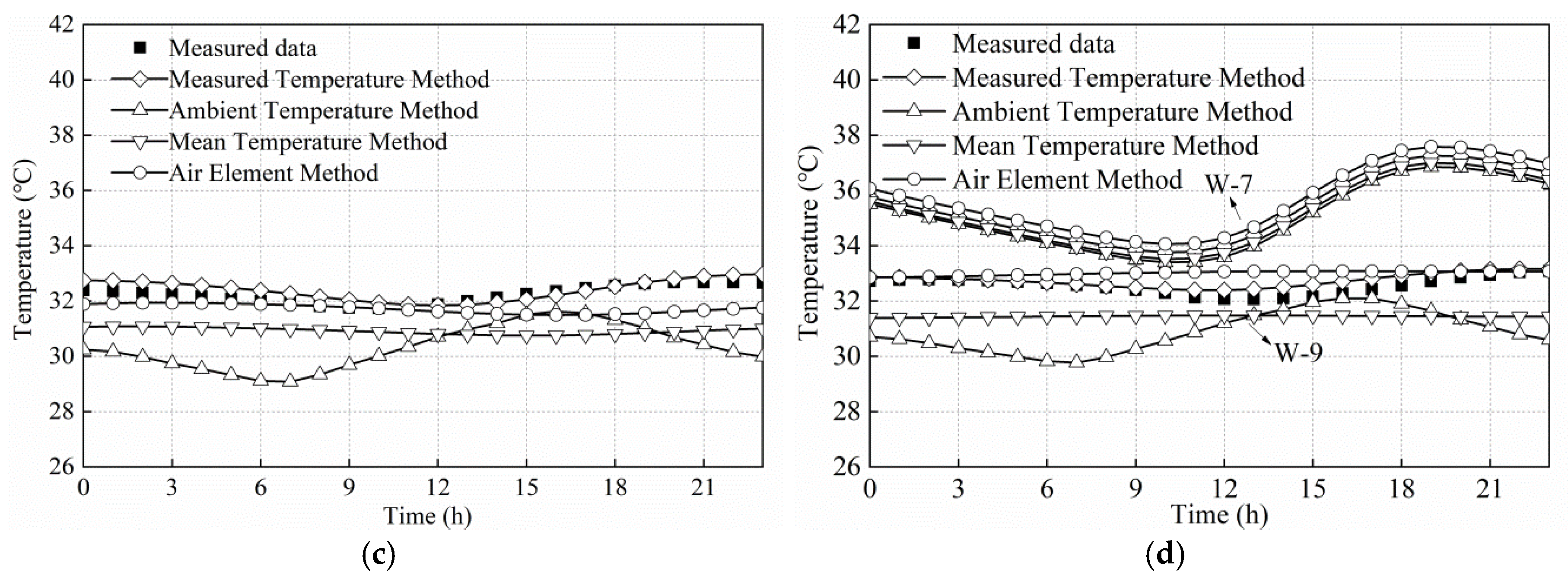
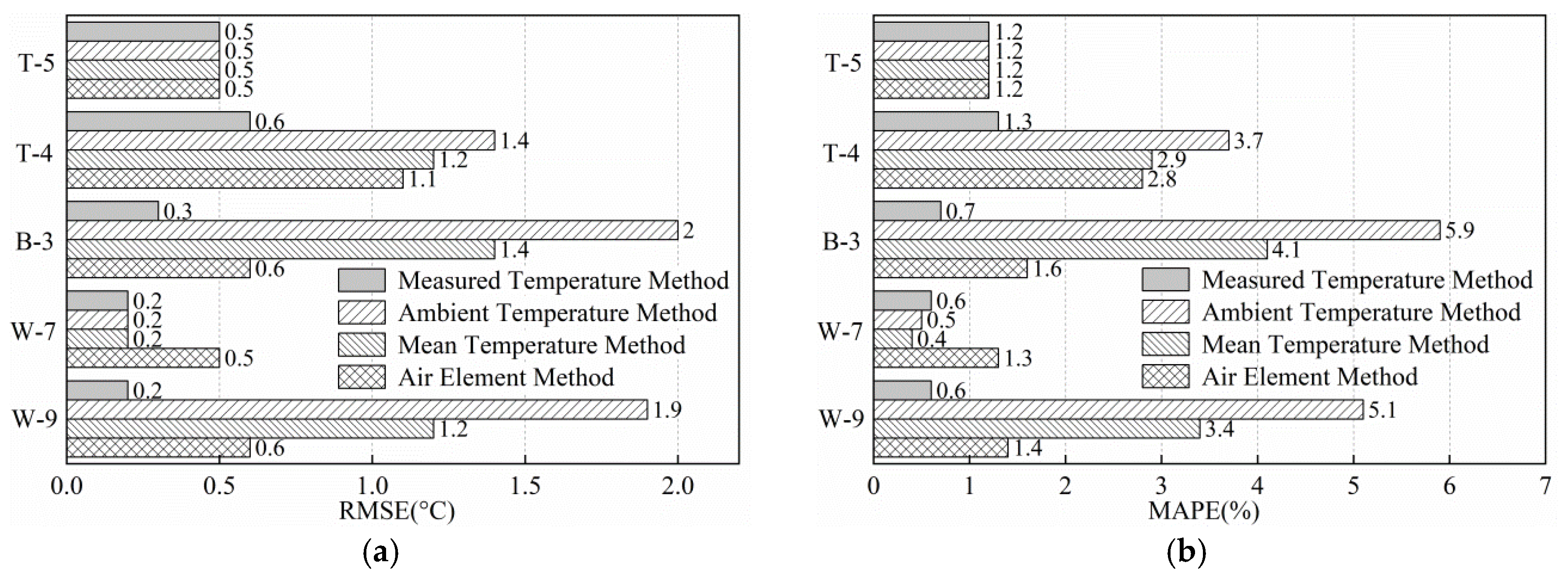
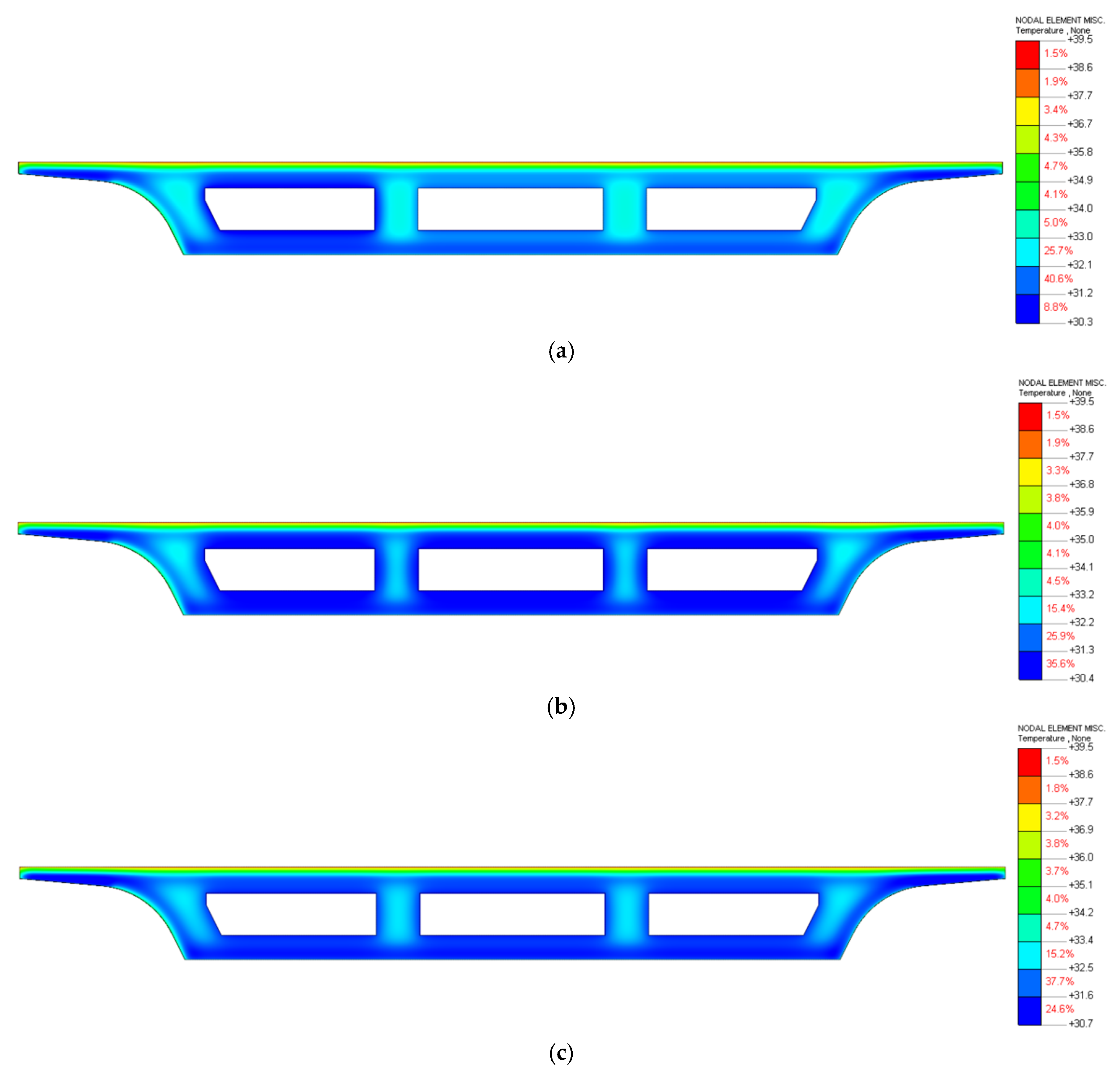

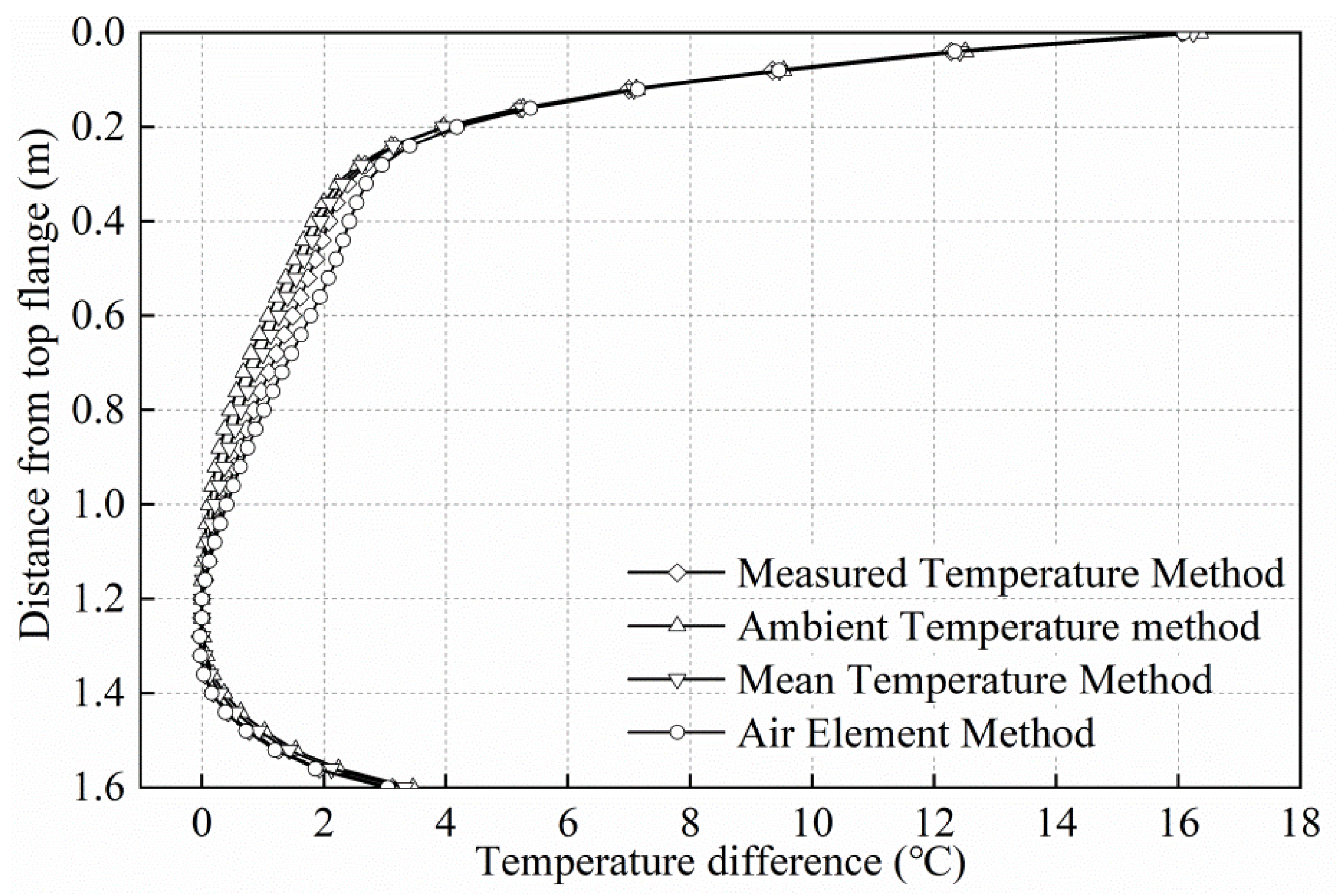
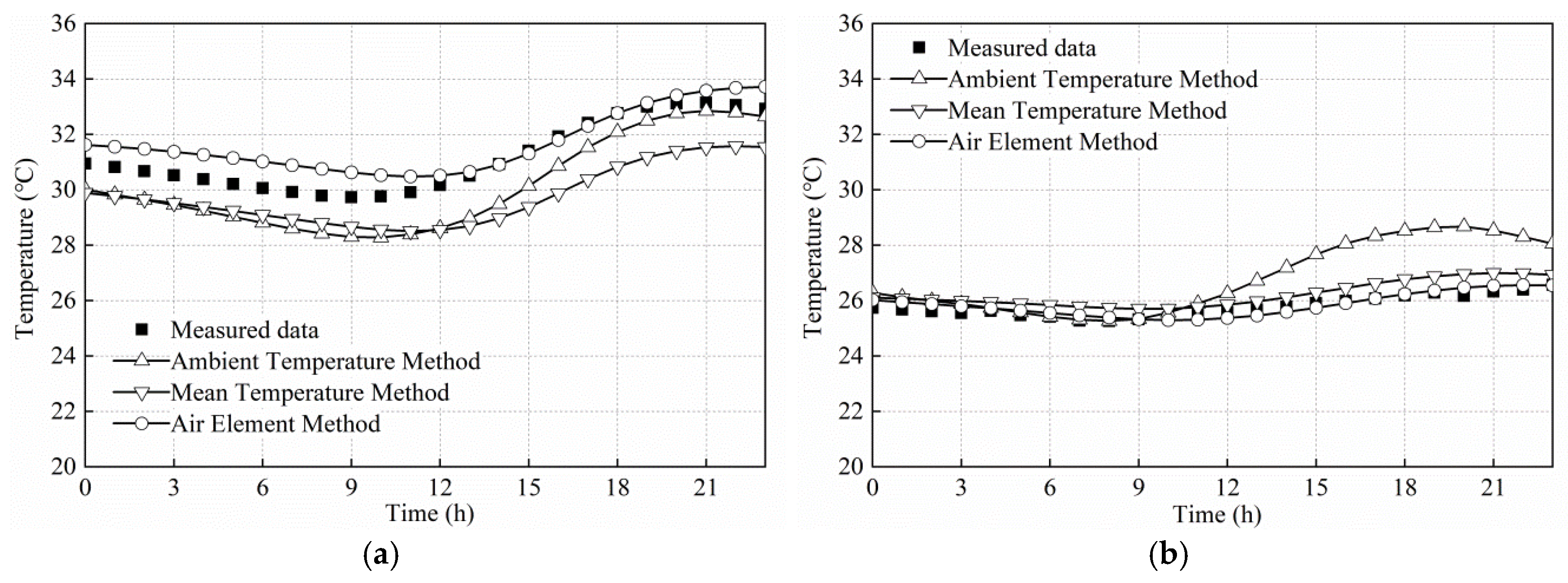
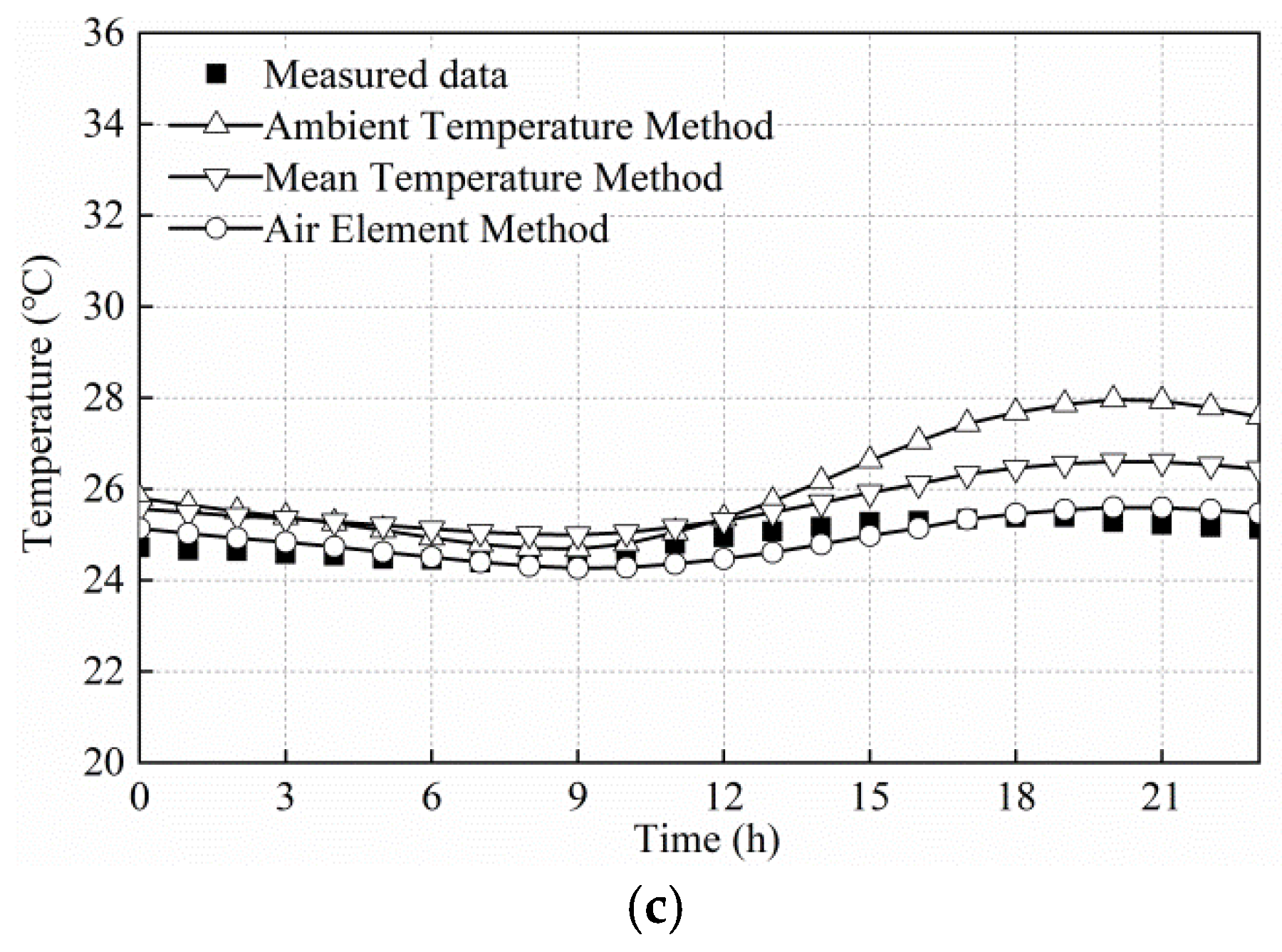
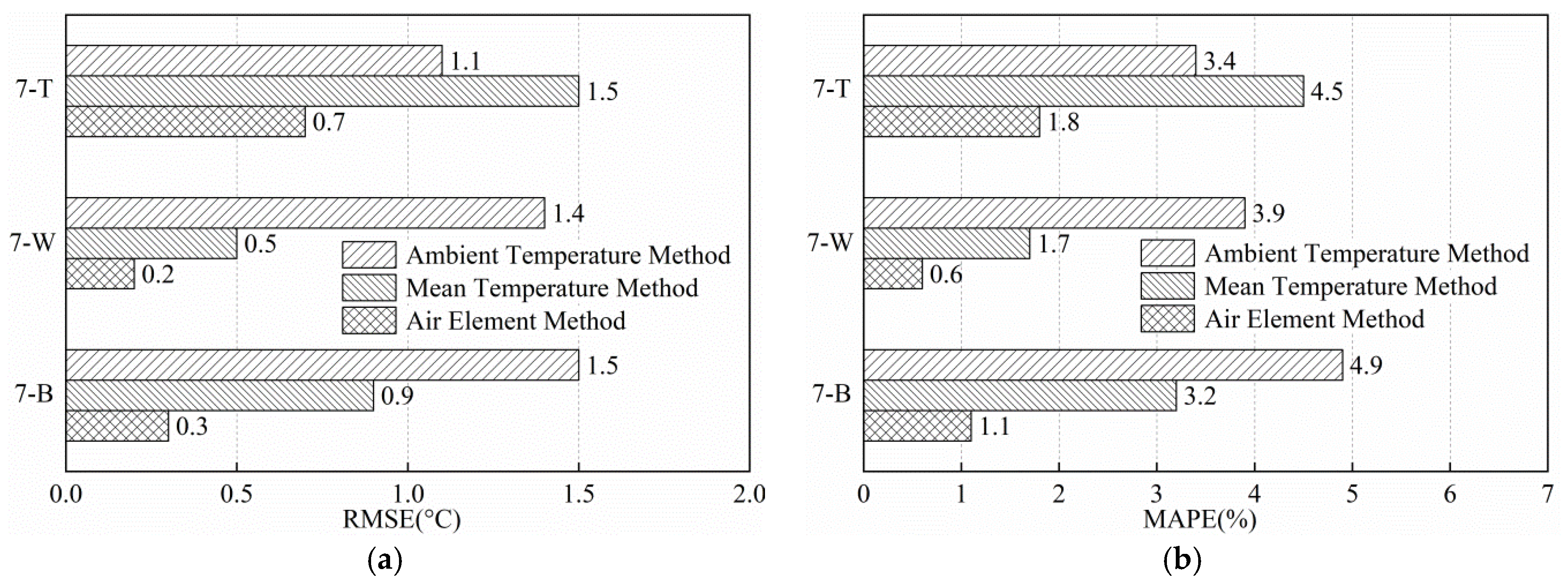
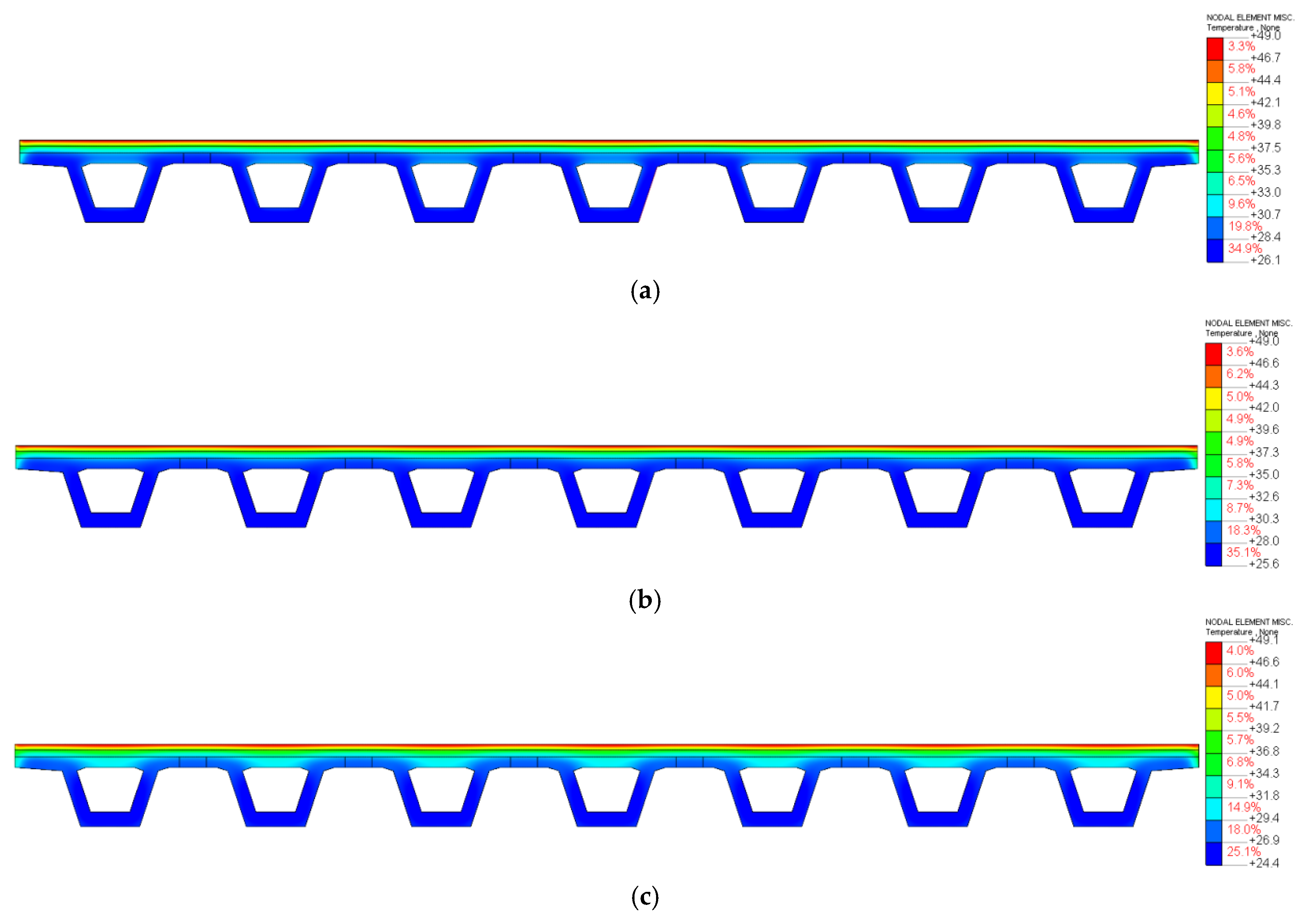
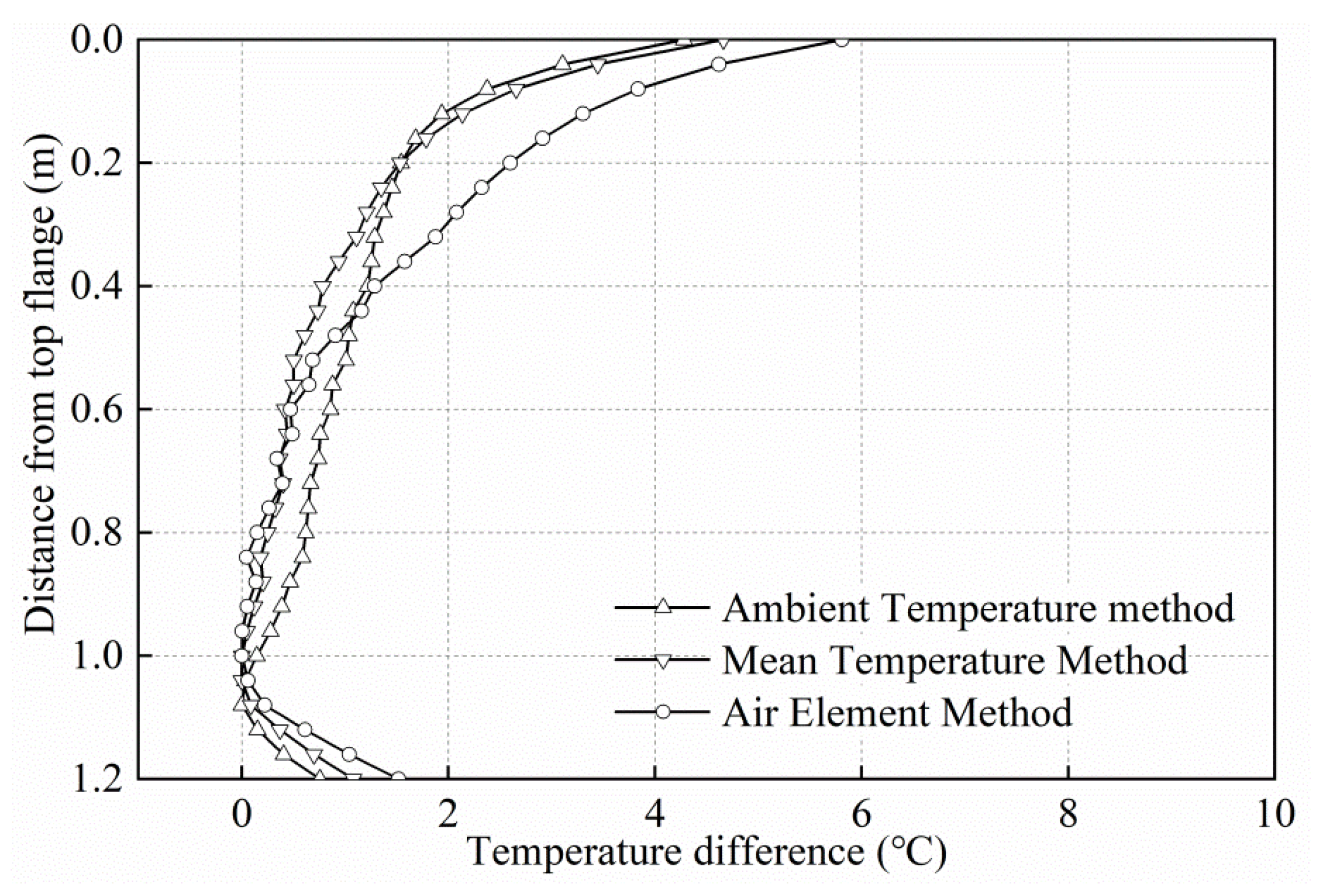
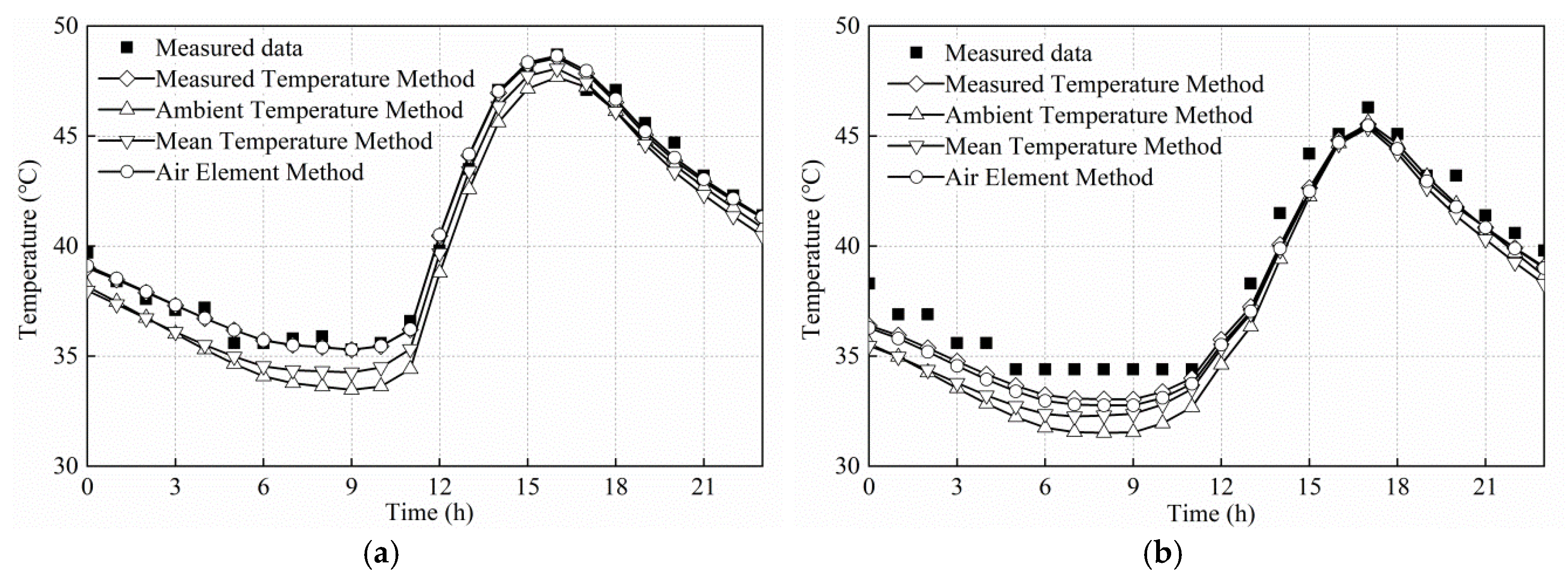
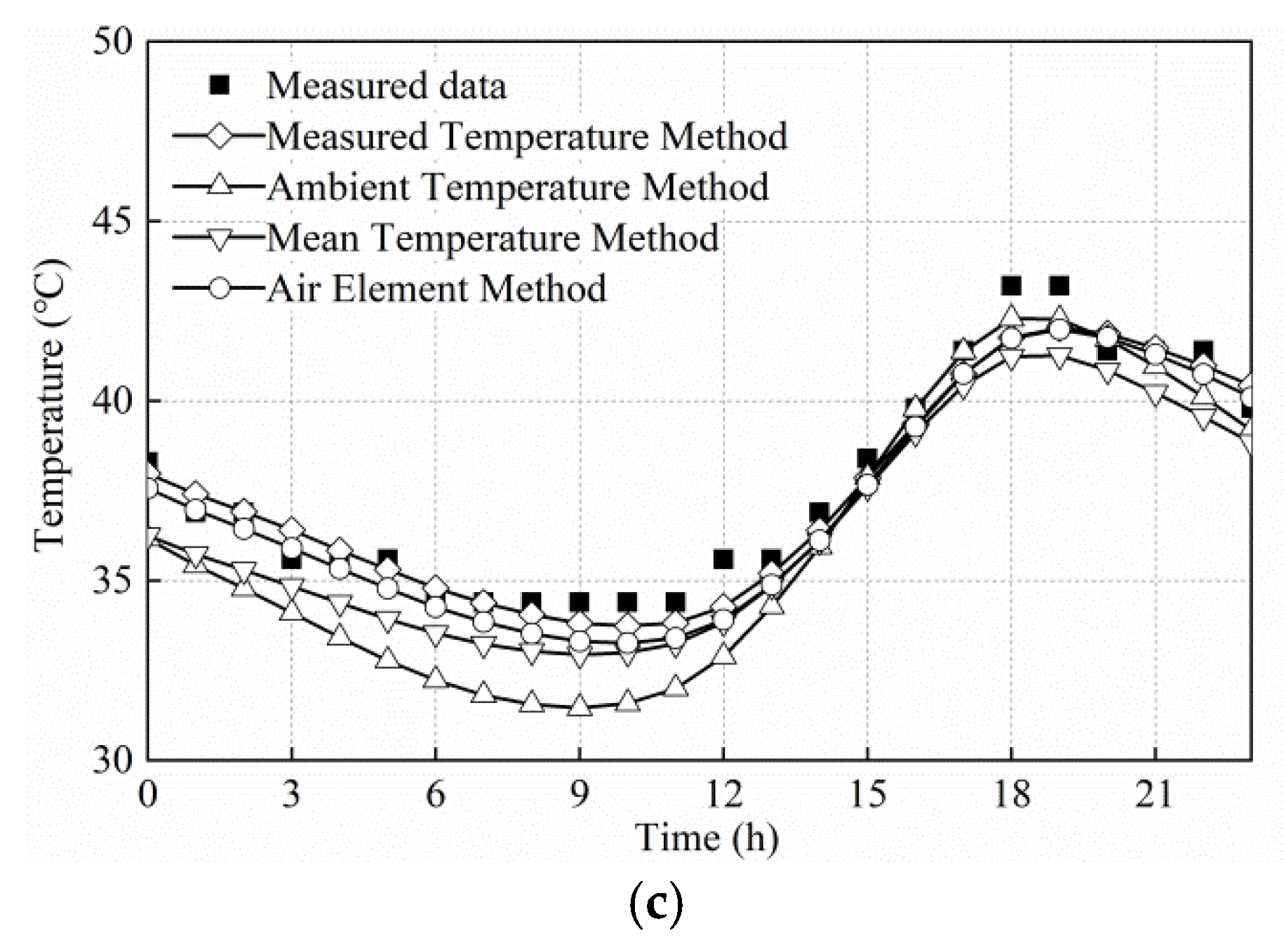
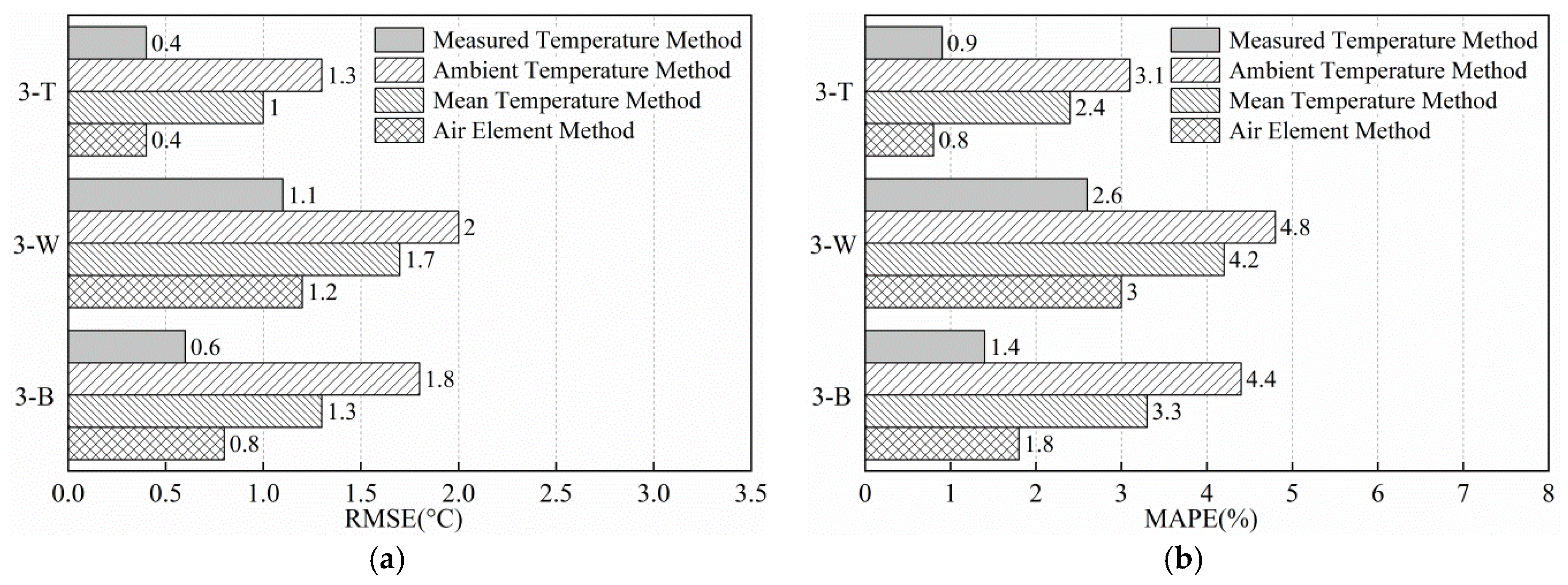
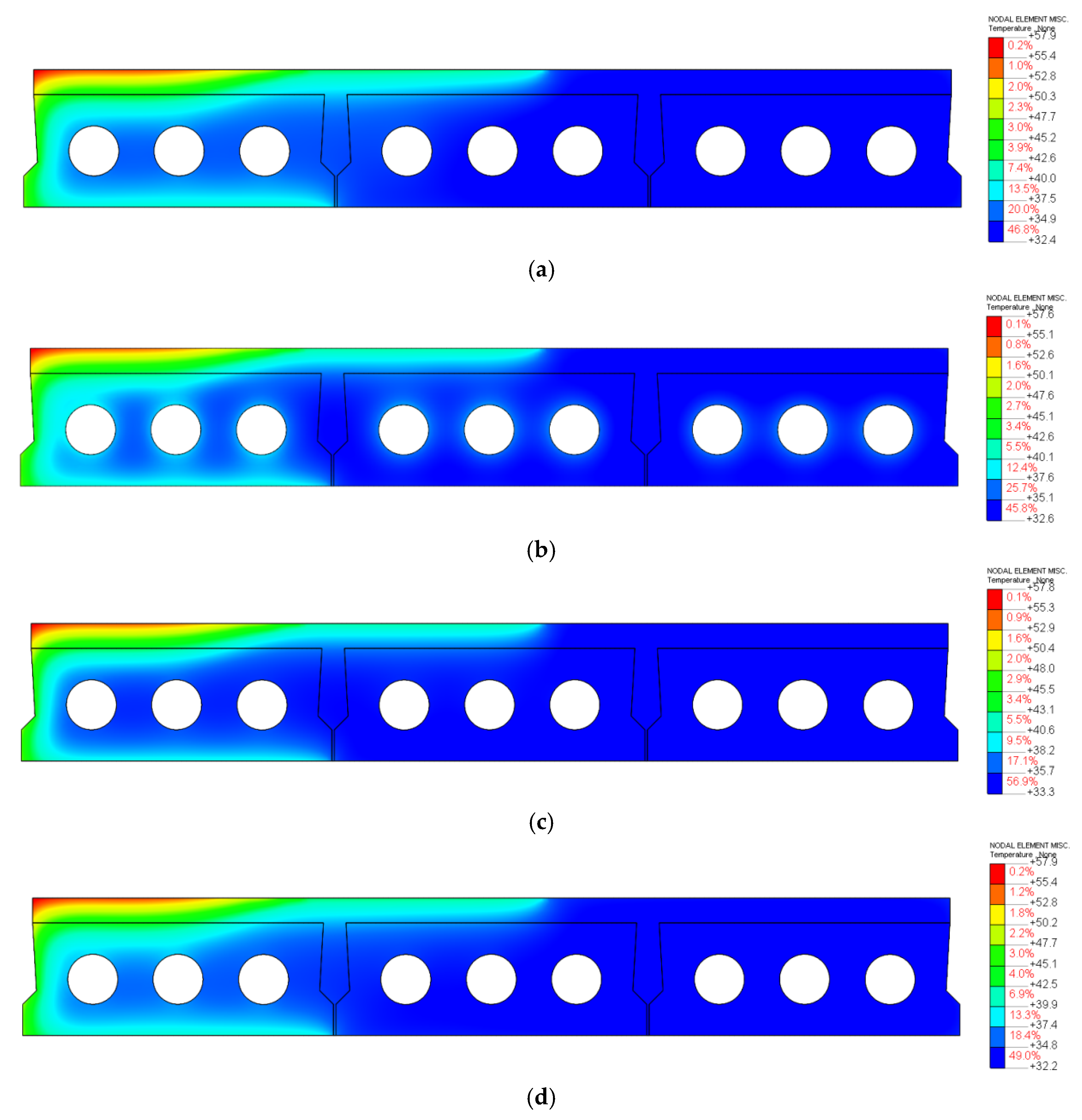
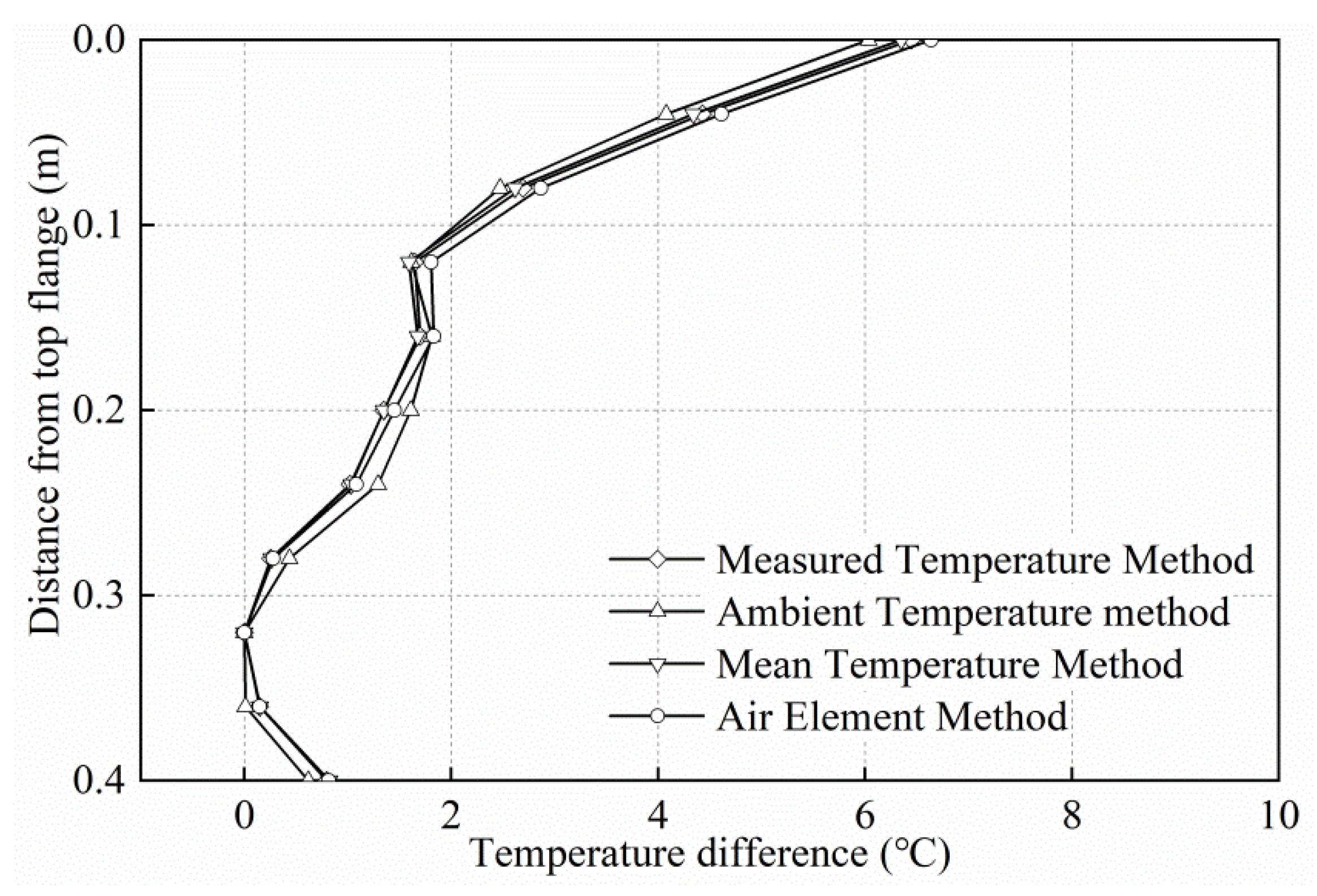


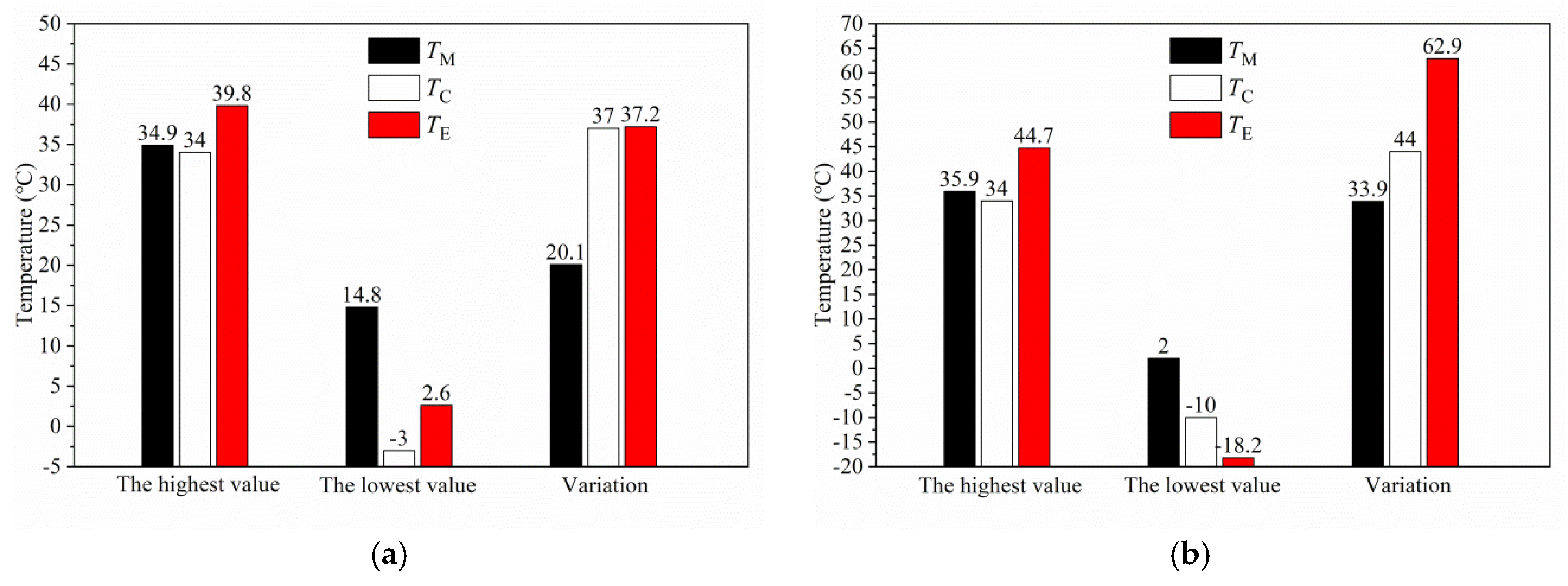
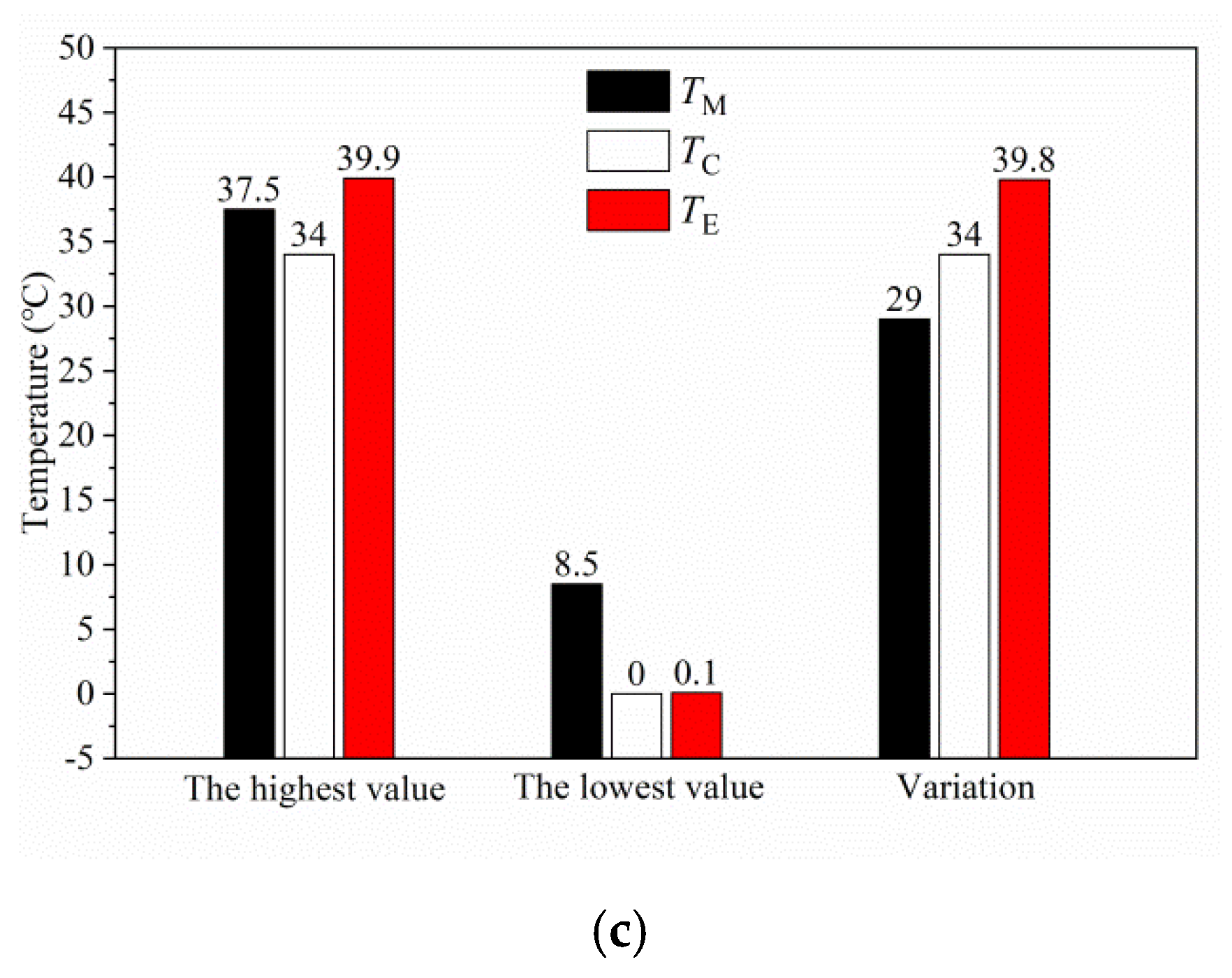
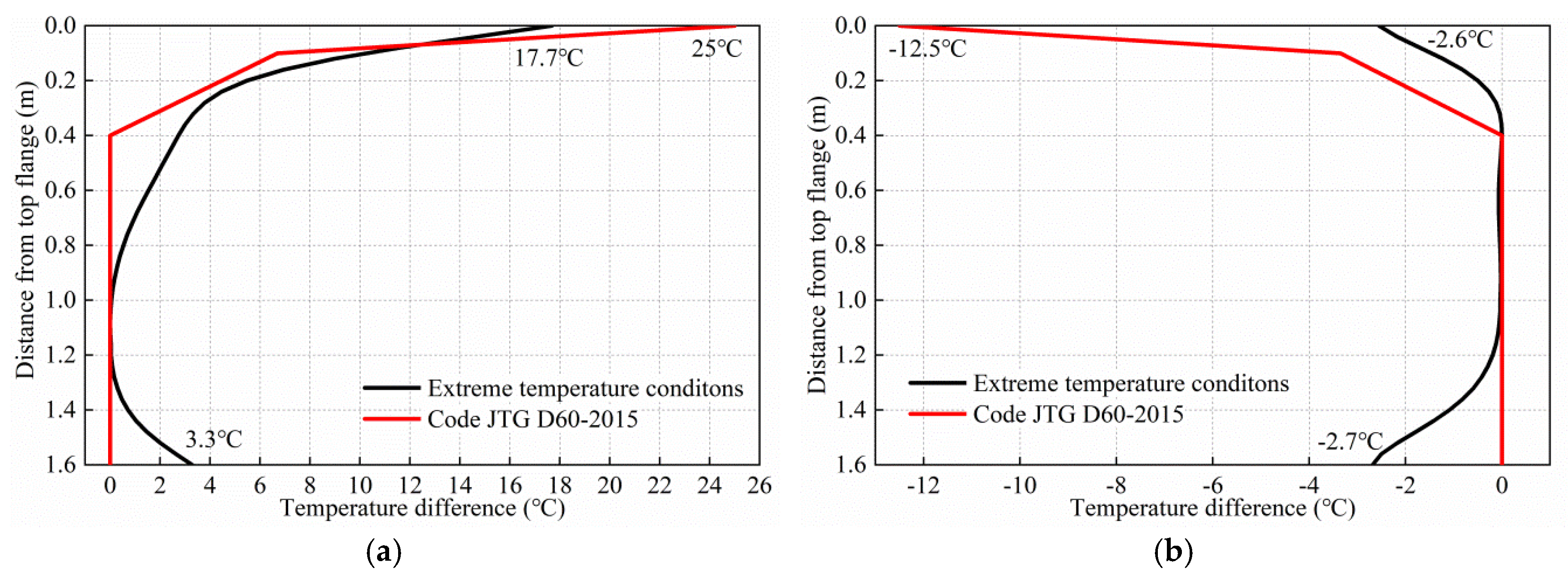
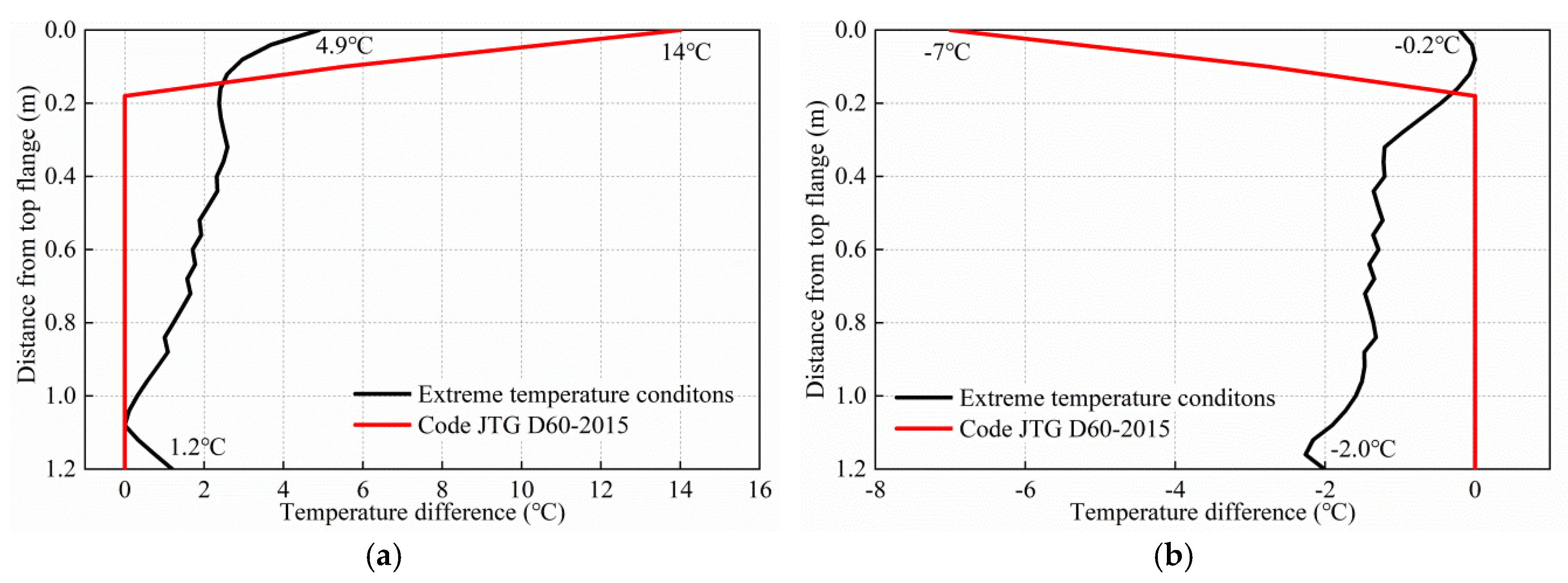
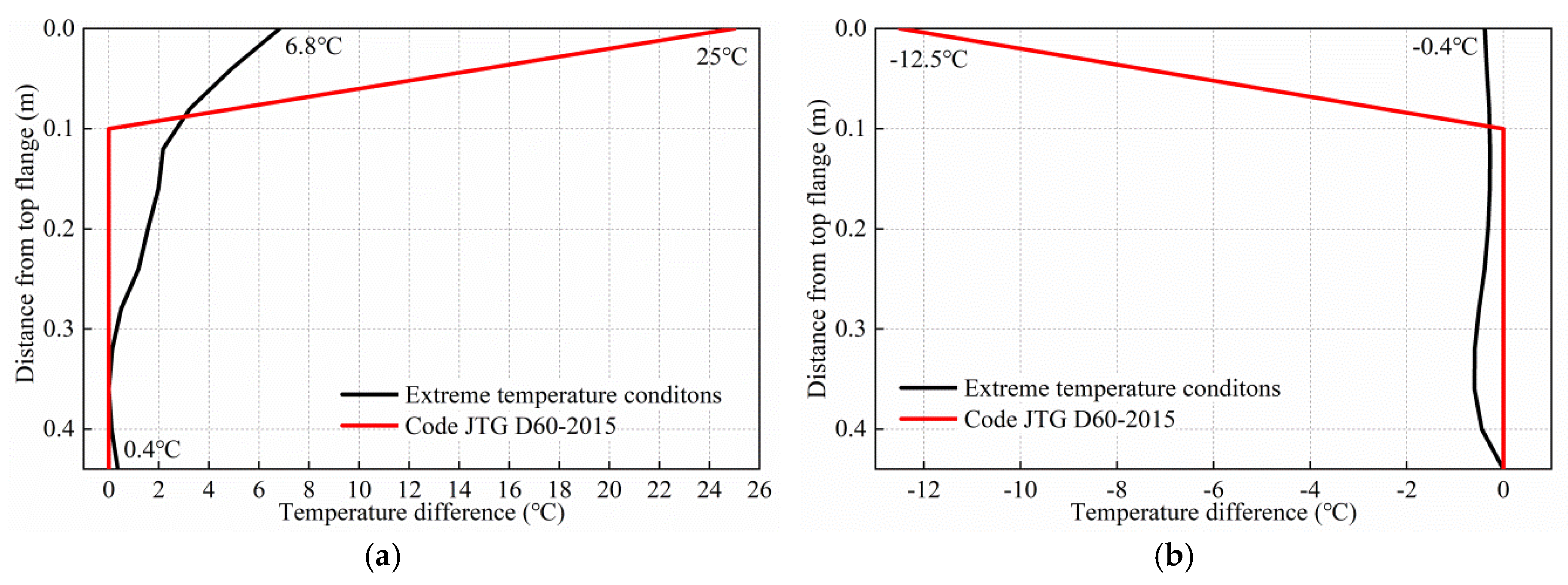
| Methods | Measured Temperature Method | Ambient Temperature Method | Mean Temperature Method | Air Element Method |
|---|---|---|---|---|
| Measured value | 34.9 | |||
| Numerical value | 35.0 | 35.0 | 34.6 | 35.6 |
| Methods | Ambient Temperature Method | Mean Temperature Method | Air Element Method |
|---|---|---|---|
| Measured value | 28.4 | ||
| Numerical value | 29.5 | 28.6 | 28.6 |
| Methods | Measured Temperature Method | Ambient Temperature Method | Mean Temperature Method | Air Element Method |
|---|---|---|---|---|
| Measured value | 37.5 | |||
| Numerical value | 37.0 | 37.8 | 37.1 | 36.7 |
| Cross-Section | Location | Ambient Air Temperature | Monthly Average Daily Temperature Range | ||
|---|---|---|---|---|---|
| Max | Min | July | January | ||
| Box girder | Shenzhen | 37.9 | −0.3 | 6.1 | 7.4 |
| Small box girder | Handan | 43.1 | −21.3 | 8.9 | 8.9 |
| Adjacent box girder | Fuzhou | 40.6 | −1.9 | 8.7 | 7.0 |
© 2020 by the authors. Licensee MDPI, Basel, Switzerland. This article is an open access article distributed under the terms and conditions of the Creative Commons Attribution (CC BY) license (http://creativecommons.org/licenses/by/4.0/).
Share and Cite
Lin, J.; Xue, J.; Huang, F.; Chen, B. Research on the Internal Thermal Boundary Conditions of Concrete Closed Girder Cross-Sections under Historically Extreme Temperature Conditions. Appl. Sci. 2020, 10, 1274. https://doi.org/10.3390/app10041274
Lin J, Xue J, Huang F, Chen B. Research on the Internal Thermal Boundary Conditions of Concrete Closed Girder Cross-Sections under Historically Extreme Temperature Conditions. Applied Sciences. 2020; 10(4):1274. https://doi.org/10.3390/app10041274
Chicago/Turabian StyleLin, Jianhui, Junqing Xue, Fuyun Huang, and Baochun Chen. 2020. "Research on the Internal Thermal Boundary Conditions of Concrete Closed Girder Cross-Sections under Historically Extreme Temperature Conditions" Applied Sciences 10, no. 4: 1274. https://doi.org/10.3390/app10041274
APA StyleLin, J., Xue, J., Huang, F., & Chen, B. (2020). Research on the Internal Thermal Boundary Conditions of Concrete Closed Girder Cross-Sections under Historically Extreme Temperature Conditions. Applied Sciences, 10(4), 1274. https://doi.org/10.3390/app10041274






